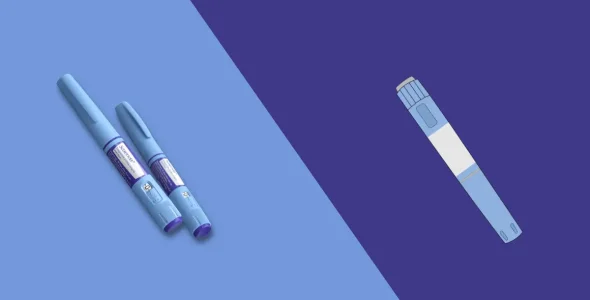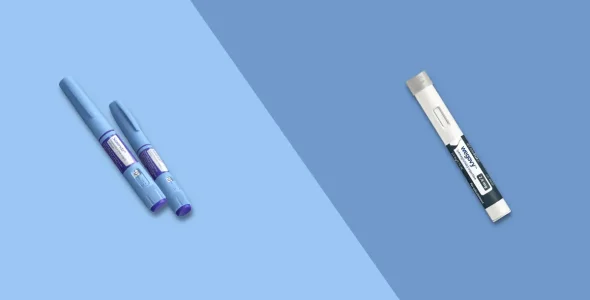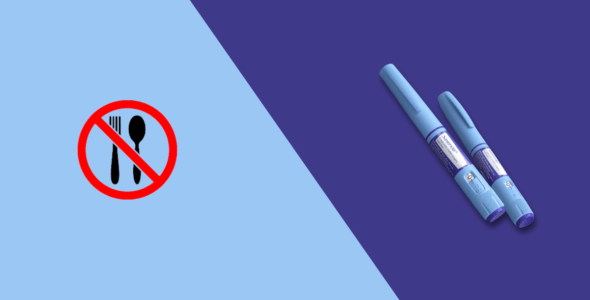Saxenda generic 2025: Is a cheaper version available?
Waiting for a more affordable Saxenda? The truth about its generic availability might surprise you. Get the latest on when you can expect a lower-cost option for your weight management journey.
Key highlights
- Saxenda is an FDA-approved glucagon-like peptide-1 (GLP-1) receptor agonist used for chronic weight management in adults and adolescents with obesity or weight-related conditions.
- No generic Saxenda is available in the U.S. as of May 2025, due to patent protections on its formulation and injection pen.
- Approved in late 2024 and early 2025, generic liraglutide is intended to replace Victoza for type 2 diabetes, but it is not approved for weight loss, unlike Saxenda.
- Compounded liraglutide is available but is not FDA-approved, and quality can vary depending on the compounding pharmacy that makes the drug.
- Switching to generic liraglutide may be an option only for those with type 2 diabetes on low Saxenda doses, but this must be evaluated by a doctor.
- Generic GLP-1 weight loss drugs like Saxenda may not be available in the U.S. until around 2033, depending on patent expirations and regulatory developments.
Saxenda (liraglutide) is an FDA-approved GLP-1 receptor agonist used for chronic weight management in adults and adolescents with obesity or weight-related conditions.
It helps reduce appetite and food intake, supporting weight loss when combined with diet and exercise.
Brand-name medications like Saxenda can be expensive, making them inaccessible for many patients. This has led to growing interest in more affordable generic or compounded alternatives for weight management.
Is there a generic for Saxenda? Learn about liraglutide alternatives, FDA approval status, and how to save on this weight loss drug in 2024.
What is Saxenda?
Saxenda is a GLP-1 medication with the same active ingredient as Victoza, liraglutide. It’s used for chronic weight management in combination with a reduced-calorie diet and increased physical activity in adults with obesity or overweight.
Saxenda is a daily injection approved for weight loss. Approved in 2010, Saxenda (liraglutide) was the first GLP-1 medication approved for weight loss in adults with obesity or overweight with at least one weight-related health condition, such as high blood pressure or high cholesterol. It is also approved for certain children 12 and older with obesity.
Saxenda, being an older GLP-1 medication, has some downsides compared to newer weight loss medications like Zepbound. For example, it’s taken daily instead of weekly, and you might lose less weight with it.
In a 56-week clinical trial, people taking Saxenda 3 mg once a day lost an average of 18 lbs, while those using a placebo injection only lost 8 lbs. It has also shown heart health benefits for people with diabetes or those at high risk of heart disease.
Is there a generic Saxenda available now? (2025)
As of May 2025, no generic Saxenda (liraglutide for weight loss) is available in the U.S. However, a generic version of Victoza, the type 2 diabetes version of liraglutide, has been approved.
On December 23, 2024, the US FDA approved Hikma Pharmaceuticals’ generic version of Victoza (liraglutide injection 18 mg/3 mL) for type 2 diabetes in adults and pediatric patients 10 years and older. This approval was part of the FDA’s efforts to address drug shortages and give patients access to essential medications.
The FDA also approved a generic version of Victoza from Nanjing King-Friend Pharmaceutical on April 2, 2025.
Compounded liraglutide is available through some pharmacies where the medication is made according to a doctor’s prescription. However, these compounded medications are not FDA-approved and may not meet the same safety, efficacy, and quality standards as FDA-approved drugs. The FDA does not review compounded drugs for safety or effectiveness, and use should be used with caution.
Saxenda is for weight management, and Victoza is for type 2 diabetes. The patents for Saxenda’s formulation and delivery device are still in effect, so a generic version for weight loss is not available at this time. The FDA’s approval of a generic version of Victoza does not apply to Saxenda.
Saxenda dosage and administration
Saxenda is a once-daily injection administered under the skin (subcutaneously). You can inject the medication under the skin of your stomach, upper arm, or thigh.
Store Saxenda in the refrigerator at a temperature between 36°F to 46°F (2°C to 8°C) before first use. Once you start using the pen, it can be kept at room temperature, up to 86°F (30°C), for a maximum of 30 days.
Be sure to protect the pen from light and heat during storage. Do not freeze Saxenda, and if it has been frozen, do not use it. Always keep the pen capped when it is not in use to maintain its effectiveness.
The starting dose of Saxenda is 0.6 mg once daily, which is used during the first week to help your body adjust and minimize side effects like nausea. The dose is then gradually increased each week until the maintenance dose of 3.0 mg is reached by the fifth week if tolerated. It should be continued as long as it’s effective and well-tolerated.
If the patient has not lost at least 4% of their body weight after 16 weeks at the maintenance dose, treatment may be discontinued, as further benefit is unlikely.
Understanding the patent landscape for Saxenda
Patents give the manufacturer exclusive rights to produce and sell a drug for 20 years from the filing date. This exclusivity allows companies to recoup research and development costs and incentivize innovation. Patents can delay the introduction of more affordable generic alternatives and increase healthcare costs.
Saxenda (liraglutide) has multiple patents, including those for the active ingredient and delivery device.
These patents cover the composition and use of liraglutide. For example, the patent for liraglutide use in cardiovascular conditions is active until July 9, 2037.
Other patents cover the Saxenda pre-filled pen device and its features. One such patent, US Patent No. 10,813,764, issued on October 27, 2020, covers the expandable introducer system and methods for the Saxenda pen. This patent is set to expire around July 2033 and is a big barrier to a direct generic of Saxenda.
These device-specific patents are key to maintaining market exclusivity for Saxenda. Even if the active ingredient patents have expired or are about to expire, the device-specific patents prevent generic versions that replicate the original device’s functionality.
Some patents have been challenged and settled, like the US8114833 patent, which was terminated and settled in 2022. However, the device-specific patents are still in effect. Any future patent challenges or settlements could impact the timeline for generic availability, but that’s speculative and depends on legal proceedings and outcomes.
The combination of expired foundational patents and active device-specific patents creates a complex patent landscape for Saxenda. The protection of the pre-filled pen device until around 2033 is a big hurdle for a direct generic, and maintaining Saxenda’s market exclusivity and high cost.
Side effects of Saxenda
The most common side effects are usually mild and tend to improve over time:
- Nausea
- Vomiting
- Diarrhea
- Constipation
- Headache
- Dizziness
- Fatigue
- Hypoglycemia or low blood sugar (especially when used with diabetes medications)
- Decreased appetite
Rare and serious side effects of Saxenda that may require immediate medical attention include:
- Pancreatitis (inflammation of the pancreas)
- Gallbladder problems (gallstones)
- Kidney problems (including kidney failure)
- Increased heart rate
- Injection site reactions
- Suicidal thoughts
- Serious allergic reactions
If you experience any of these side effects, speak with your doctor right away.
Saxenda has a black box warning from the FDA for the risk of thyroid tumors or thyroid cancer, including medullary thyroid carcinoma (MTC).
You should not use Saxenda if you:
- Have a personal or family history of medullary thyroid cancer or Multiple Endocrine Neoplasia syndrome type 2 (MEN 2)
- Are pregnant or planning to become pregnant
- Are breastfeeding, as it is not known if Saxenda passes into breast milk
- Have serious kidney or liver problems
The arrival of generic liraglutide: What it means for patients
In late 2024 and early 2025, the FDA approved generic versions of liraglutide injection, a big deal for type 2 diabetes patients. These generics are the same as Victoza, the branded medication developed by Novo Nordisk to lower blood sugar and reduce cardiovascular risk in certain adults with diabetes.
Here are the differences between generic liraglutide and generic Saxenda:
- Indication: The generic liraglutide available now is approved for type 2 diabetes (to control blood sugar and cardiovascular risk reduction in some adults), not for weight loss. It’s a generic form of Victoza, not Saxenda.
- Dosage: Saxenda’s weight loss dose is 3.0 mg per day, while Victoza and its generic are approved up to 1.8 mg daily.
- Approved use: Generic liraglutide cannot be marketed or substituted for Saxenda for weight management, as it’s not approved for that use or dosage.
The arrival of generic liraglutide means big cost savings for diabetes patients who were on the brand-name Victoza. Generics generally offer a more affordable option, enhancing access and adherence.
However, patients using Saxenda for weight loss won’t benefit from those savings as generic liraglutide is not an approved substitute since it has a lower dosage and different indication.
Although both have liraglutide, they are not interchangeable. The formulations, indications, and approved dosages are different.
While generic liraglutide is a step forward for affordability in diabetes care, it’s not a substitute for Saxenda for weight management.
When will generic Saxenda be available?
Saxenda’s patent is set to expire in 2023, but several pharmaceutical companies are already working on their generic versions.
The good news is that generic versions of Victoza, another medication that also contains liraglutide, are already FDA approved and available since December 2024.
Teva Pharmaceuticals has launched an authorized generic version of Victoza (liraglutide) for type 2 diabetes. This is available in the U.S. and will get a label extension for weight loss indications in the future. WAC is 13.6% lower than the brand name at $469.60 for a 2-pack and $704.40 for a 3-pack.
Hikma Pharmaceuticals got FDA approval for its generic liraglutide injection in December 2024. This is for type 2 diabetes only and not yet for weight loss.
Other companies like Mylan (Viatris), Pfizer, and Sandoz are also developing generic liraglutide products. These will enter the market in 2025 pending approvals.
To track updates on approvals and label extensions for generic liraglutide products, check the FDA’s Orange Book, officially known as Approved Drug Products with Therapeutic Equivalence Evaluations.
Generic versions for type 2 diabetes may receive label extensions for weight loss in the future.
The introduction of multiple generics will reduce costs and increase access for patients.
If you’re planning to switch to generic Saxenda, consult your healthcare provider to discuss the best and most cost-effective options for you.
Can you switch from Saxenda to generic liraglutide (generic Victoza)?
Always consult your healthcare provider before making any changes to your medication regimen. Saxenda and generic liraglutide (a generic form of Victoza) may contain the same active ingredient, liraglutide, but they are not interchangeable due to differences in dosage, approved uses, and intended outcomes.
For some patients, particularly those using lower doses of Saxenda (under 1.8 mg) and who also have type 2 diabetes, switching to generic liraglutide might be considered. However, this should be a carefully evaluated medical decision, weighing the potential benefits, risks, and treatment goals.
Factors that your healthcare provider will consider include:
Primary treatment goal
Generic liraglutide is only FDA-approved for diabetes management, not for weight loss at Saxenda’s higher doses.
Current Saxenda dosage
Saxenda is used up to 3 mg daily, while generic liraglutide (Victoza equivalent) only goes up to 1.8 mg daily.
Patients on higher doses (e.g., 2.4 mg or 3 mg) may not experience the same level of appetite suppression or weight loss as on the lower dose.
Individual response and tolerability
People respond differently to medications and delivery systems.
Your healthcare provider will assess how well you’ve tolerated Saxenda and whether a different formulation or dose could affect side effects or effectiveness.
Insurance coverage
Generic liraglutide is often cheaper and more widely covered than Saxenda, but switching to it off-label for weight loss may not be reimbursed by insurance.
Can you switch from Saxenda to compounded liraglutide?
You can switch from Saxenda to compounded liraglutide if your healthcare provider decides that it is medically appropriate, but it’s important to do so only under medical supervision. While both contain the same active ingredient (liraglutide), compounded versions are not FDA-approved, which means their quality, dose accuracy, and sterility may vary.
Switching without guidance can increase risks like incorrect dosing, side effects, or reduced effectiveness. If cost is a concern, talk to your doctor about safe alternatives and ensure the compounding pharmacy is licensed and reputable.
Other potential future generic options for weight loss
Other GLP-1 receptor agonists approved for weight loss, like Wegovy (semaglutide), currently do not have generic versions available. These drugs are still under patent protection, which means it will likely be several years before generics can be legally produced and sold.
Each medication has its own patent timeline. Wegovy’s patents are expected to last until around 2032, depending on the region and legal developments. Once these patents expire, generic versions may become available, which could significantly lower the cost of these medications.
Sandoz has announced plans to launch generic Ozempic and Wegovy in Canada in 2026, but the generic will not be available in the U.S. until at least 2031.
As patents expire and manufacturing technologies improve, more affordable generic options may enter the market, expanding access to effective treatments for obesity. This broader future could help reduce the financial burden for patients seeking long-term weight management.
Strategies for managing the cost of Saxenda
For many patients, the high cost of Saxenda can be a major barrier to starting or continuing treatment, especially given the lack of a direct generic alternative.
Here are practical strategies to help manage expenses:
Check insurance coverage
Look up your health plan’s formulary to see if Saxenda is covered. Ask your insurance provider if there are any prior authorization or step therapy requirements that may apply. Have your provider’s office help with the insurance approval process if needed.
Explore manufacturer savings programs
Novo Nordisk, the maker of Saxenda, offers savings cards for eligible patients. Visit Saxenda.com or call Novo Nordisk’s support line to see if you qualify and apply.
Use pharmacy discount cards
Services like GoodRx, SingleCare, and WellRx often offer discount coupons that can lower your out-of-pocket cost, even without insurance. Prices may vary by pharmacy, so compare and shop around.
Discuss alternatives with your doctor
Ask your healthcare provider if other GLP-1 meds (Wegovy, Ozempic, or even generic liraglutide) might be an option, knowing they may have different indications, dosing, and effects.
Other weight loss medications like Contrave, Qsymia, or Phentermine may be cheaper and have generic versions.
FAQs
Is compounded liraglutide safe?
Compounded liraglutide may not be as safe as the FDA-approved version because it isn’t regulated or tested the same way. It can carry risks like incorrect dosing or contamination, depending on the compounding pharmacy, so it’s best to use only the approved medication prescribed by a doctor.
Will generic Saxenda work the same?
A generic version of Saxenda could work the same if it’s approved by the FDA, meaning it has the same active ingredient and effectiveness.
Can I use Victoza for weight loss?
Victoza is mainly used to treat type 2 diabetes, but it can help with weight loss in some people. However, Saxenda (which has the same ingredient at a higher dose) is the version approved for weight loss, so talk to your doctor before using Victoza for that purpose.
How much will generic Saxenda cost?
Right now, there isn’t a generic version of Saxenda available in the U.S., so it still costs around $1,300 a month without insurance.
How to save on Saxenda until the generic arrives
Here are some strategies that can be used to save on Saxenda:
Saxenda Savings Card program
Novo Nordisk, the manufacturer of Saxenda, offers a Saxenda savings card program, which is eligible for commercially insured patients who may pay as little as $25 per 30-day prescription.
This card can be used at participating pharmacies. It is not valid for patients on Medicare, Medicaid, or other federal/state healthcare programs.
Pharmacy discount cards
Free discount programs like GoodRx, SingleCare, and WellRx may help lower out-of-pocket costs if you’re paying cash.
Prices can vary, so it’s worth comparing across all prescription drug discount websites and local pharmacies.
Generic liraglutide
The FDA approved generic liraglutide (Victoza), the first generic of a once-daily GLP-1 injection, in December 2024.
Compounded liraglutide
Compounded liraglutide is made by compounding pharmacies, which mix medications tailored to individual needs, often when the original drug is unavailable or too expensive. Unlike FDA-approved medications like Saxenda or Victoza, compounded drugs are not reviewed for safety, effectiveness, or quality by the FDA. This means there could be risks, such as incorrect strength, contamination, or improper storage.
If you’re considering compounded liraglutide, it’s important to speak with a healthcare provider. They can help you weigh the risks and benefits and ensure you’re using a product from a reputable source if it’s appropriate for you.
Other GLP-1 agonists
It’s essential to remember that any changes to your weight loss medication, whether starting, stopping, or switching, depend on your medical condition and should only be made under the medical advice of a qualified healthcare provider. Always tell your doctor or pharmacist about all over-the-counter medications, supplements, and vitamins you take. Consider speaking to your healthcare professional about any of these Saxenda alternatives:
Wegovy (semaglutide)
Both Saxenda (liraglutide) and Wegovy (semaglutide) are GLP-1 receptor agonists approved for weight loss, but they differ in cost and insurance coverage.
Insurance coverage for these medications can differ depending on the plan, but most insurance plans don’t cover weight-loss treatments. Some plans may cover Saxenda or Wegovy, while others may not, so many patients might have to pay the full price. A month’s supply of Saxenda and Wegovy costs about $1,300 without insurance.
The coverage for both drugs varies by insurance plan. Some plans may cover them, but they are not typically covered by Medicare Part D for weight loss.
Victoza (liraglutide)
Victoza (liraglutide) is a once-daily injectable medication approved by the U.S. Food and Drug Administration (FDA) for managing type 2 diabetes in adults and children aged 10 years and older. It works by enhancing insulin release in response to meals, thereby improving blood sugar control when used alongside diet and exercise.
While not specifically approved for weight loss, some individuals with type 2 diabetes may experience modest weight reduction as a secondary benefit of Victoza. In clinical studies, patients using Victoza alone or in combination with other diabetes medications like metformin have reported average weight losses ranging from 4.6 to 6.2 pounds over 26 to 52 weeks.
Mounjaro (tirzepatide)
Mounjaro (tirzepatide) is an FDA-approved medication to improve blood sugar levels in adults with type 2 diabetes. It’s also prescribed off-label for reducing body weight combined with diet and exercise.
Mounjaro works by targeting two hormones (GLP-1 and GIP), unlike Ozempic, which only targets GLP-1, which may explain its stronger effects. It’s a powerful option, but the higher cost can be a barrier for many patients.
Mounjaro is a newer injectable medication that is more potent than Ozempic for both blood sugar control and weight loss. However, it is also more expensive and may not be covered by all insurance plans.
Conclusion
As of now, there is no direct generic equivalent to Saxenda for weight loss in the U.S. due to ongoing patent protections, especially on its formulation and delivery pen.
If eligible, you can get brand-name Saxenda with manufacturer savings programs to reduce costs.
While generic liraglutide (generic Victoza) is now available for type 2 diabetes, it is not approved or dosed for weight loss and is not a direct substitute for Saxenda.
Consider Wegovy or Zepbound if covered by insurance. Compounded liraglutide may be an option if medically appropriate but is not FDA-reviewed for safety or efficacy.
Generic Saxenda or other GLP-1 generics for weight loss may emerge around 2033, though market developments (like patent challenges) could change this.
Talk to your doctor about your health goals, insurance, and budget to find the most suitable and affordable treatment plan.





